
Finding and implementing new products and techniques that save time is an essential part of increasing overall efficiency. Not only does cutting down on the duration of a procedure add extra time back into your patient’s day, but it also means you’ll be able to treat even more patients. It’s truly a win-win situation.
While patients of all ages appreciate shorter procedures, it’s typically younger patients who benefit the most. Whenever a child is involved, it’s important to incorporate the most efficient options available. Specifically, when performing restorations, it’s essential to have a restorative delivery system on hand that is fast and easy to use and dispenses a controlled volume of material.
Case Study
A 10-year-old patient chipped his right central incisor while playing with the family cat. The case was treated during an emergency visit. The treatment plan included using a flowable composite to fix the margin enamel chipping that had taken place.
While flowable composites provide many desirable features, the materials themselves can often contain air bubbles. If these bubbles go undetected, and the composite is cured, a time-consuming repair may be needed to achieve an aesthetic and color-stable final restoration.
Knowing this, I chose 3M Filtek Supreme Flowable Restorative, which features an improved syringe design that virtually eliminates bubbles and material run-on during the dispensing process.
The situation pre-operatively was a fracture on the upper-right central incisor (Figure 1). The palatal pre-operative view shows how little tooth structure was missing and, conversely, how little composite would be required for the overall restorative procedure (Figure 2).
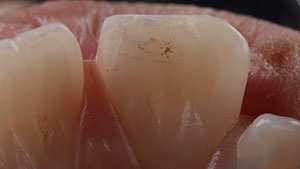 |
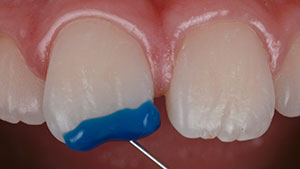 |
| Figure 2. Pre-operative palatal view. | Figure 3. Tooth was etched using 3M Scotchbond Universal Etchant. |
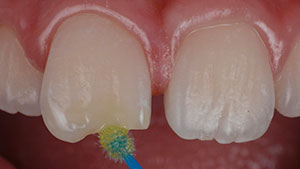 |
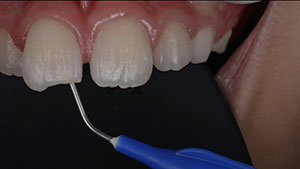 |
| Figure 4. 3M Scotchbond Universal Adhesive was applied. | Figure 5. 3M Filtek Supreme Flowable Restorative was applied. |
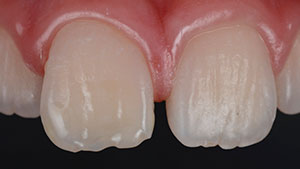 |
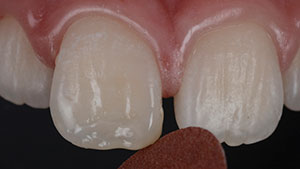 |
| Figure 6. The first layer of 3M Filtek Supreme Flowable Restorative prior to light curing. | Figure 7. Second layer of flowable is applied and also light cured. |
After cleaning delicately with a 3M Sof-Lex Extra-Thin Contouring and Polishing Disc (Coarse Grit), the tooth was etched for 15 seconds using 3M Scotchbond Universal Etchant and rinsed for 20 seconds (Figure 3). Next, 3M Scotchbond Universal Adhesive was applied, rubbed for 20 seconds, treated with a gentle stream of air for solvent evaporation, and light cured for 10 seconds (Figure 4).
Filtek Supreme Flowable Restorative was applied directly from the needle tip delivery system to the incisal edge in need of repair (Figure 5). Prior to light curing, the first layer of the flowable restorative was stable on the tooth, and there was no running or dripping of the material (Figure 6).
After the first layer of flowable was cured for 10 seconds with a 3M Elipar S10 LED curing light, the second layer of flowable was applied and also light cured (Figure 7). A Sof-Lex Extra-Thin Contouring and Polishing Disc (Coarse Grit) was used to create the general form of the tooth. Next, a slow speed coarse bur from the Styleitaliano Finishing Bur Kit was used to recreate the original texture of the tooth (Figure 8).
To obtain the final restorative luster, the two-step 3M Sof-Lex Diamond Polishing System was used (Figure 9). The final aesthetic result reveals an excellent match in both color and form (Figure 10). The margin of the restoration was undetectable, even without having prepared the tooth, thanks to the excellent adaptation of the 3M Filtek Flowable Restorative to the natural tooth structure.
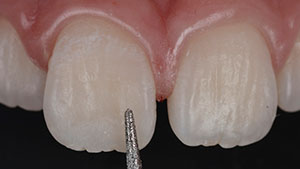 |
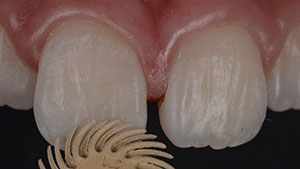 |
| Figure 8. A slow speed coarse bur (Styleitaliano Finishing Bur Kit) recreates the original texture of the tooth. | Figure 9. The 3M Sof-Lex Diamond Polishing System was used. |
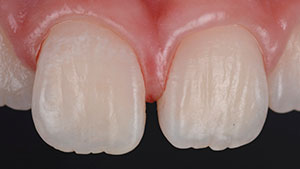 |
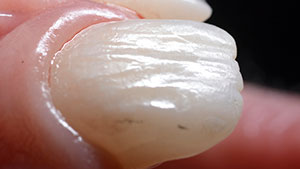 |
| Figure 10. The final esthetic result. |
Figure 11. Showing that the margin of the restoration is undetectable. |
Conclusion
Overall, the Filtek Supreme Flowable Restorative was easy to dispense, it allowed for precise placement, and the final restoration was free of voids or defects. In a 10-minute procedure, it was possible to aesthetically integrate the flowable restorative into the patient’s natural tooth structure, making it an effective and efficient treatment option.
Dr. Devoto graduated with honors in dentistry and dental prosthesis in 1991 from the University of Genoa, Italy. He is particularly interested in the fields of conservative dentistry and aesthetic dentistry and runs his own private practices in Sestri Levante and Portofino. In addition, he is collaborating with diverse prestigious dental offices throughout Europe that specialize in aesthetic dentistry. He has worked as a teacher and demonstrator at the University of Genoa and as a lecturer at the universities of Siena and Madrid. Now, he is a lecturer at the International University of Catalonia, Barcelona, and visiting professor at the Universitè de la Mediterranee, Marseille.
Related Articles
Flowable Composites to Feature Improved Syringe Design
Compromised Implant: An Interdisciplinary Rescue Treatment
Long-Term Stabilization for Interdisciplinary Care











